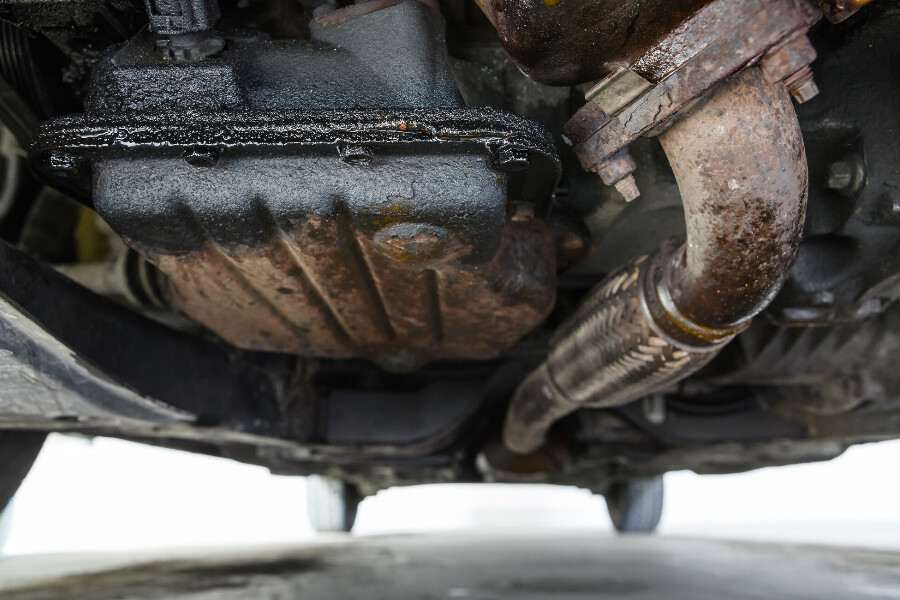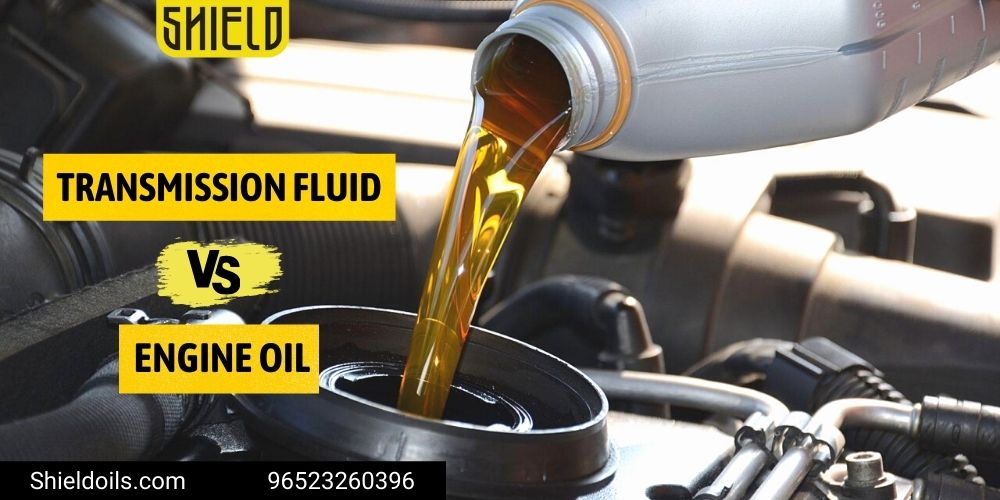- Jeep Cherokee Push Button Start Not Working: Troubleshooting Tips To Get You Back on the Road Fast! - 11 November 2023
- Haval H2 Problems: The Complete Troubleshooting Guide - 11 November 2023
- Gwm P Series Problems: Troubleshooting Guide for Common Issues - 11 November 2023
Car leaking oil between the transmission and engine generally indicates a problem with the rear main seal or a front seal on the transmission. It is important to identify the source of the leak to prevent further damage to the vehicle.
In some cases, the leak may be due to a faulty gasket or seal, which can be repaired by replacing the damaged part. However, the installation process can be labor-intensive and time-consuming. Therefore, it is recommended to seek professional assistance to fix a transmission oil leak.
Failure to address the issue may lead to transmission problems and further damage to the vehicle.

Credit: reliable-auto.com
Causes Of Oil Leak Between Transmission And Engine
An oil leak between the transmission and engine can be a frustrating issue for car owners. Not only does it lead to a loss of oil, but it can also result in other problems if left unaddressed. There are several potential causes for this type of leak, including:
1. Worn Out Valve Cover Gasket
The valve cover gasket is responsible for sealing the gap between the valve cover and the engine block. Over time, this gasket can wear out or become damaged, leading to oil leaks. When the gasket fails, oil can seep out and accumulate between the transmission and engine. This can be easily identified by oil dripping down the backside of the engine or visible oil pooling in the area.
2. Faulty Rear Main Seal
The rear main seal is located at the back of the engine and is responsible for preventing oil from leaking past the crankshaft flange. As the engine wears over time, the seal may deteriorate or develop cracks, allowing oil to escape. A leaking rear main seal can result in oil pooling between the transmission and engine, and may also cause oil to drip from the bottom of the bellhousing at the front of the transmission.
3. Shared Cooler Between Engine Oil And Transmission Oil
In some vehicles, the engine oil and transmission oil are cooled using a shared cooler. This cooler is typically located in the radiator or a separate cooler unit. If the cooler develops a leak or becomes damaged, it can cause the two types of oil to mix and result in an oil leak between the transmission and engine. This type of leak can often be identified by the presence of both engine oil and transmission fluid in the area.
When faced with an oil leak between the transmission and engine, it is important to address the issue promptly. Ignoring the problem can lead to further damage to the engine and transmission, resulting in costly repairs. If you notice any signs of an oil leak, such as oil pooling or dripping, it is recommended to have your vehicle inspected by a qualified mechanic to determine the exact cause of the leak and take the necessary steps to fix it.
Symptoms Of Oil Leak Between Transmission And Engine
An oil leak between the transmission and engine in a car can lead to a loss of oil where the two are connected. This can be caused by issues like a faulty valve cover gasket, rear main seal, or a shared cooler between the engine and transmission.
An oil leak between the transmission and engine in a car can lead to various symptoms that may require immediate attention. If you notice any of these signs, it is crucial to address the issue promptly to prevent further damage and potential transmission problems. Here are a few common symptoms of an oil leak between the transmission and engine:
Oil On The Bell Housing And Transmission
If you observe oil accumulation on the bell housing and transmission of your car, it may indicate an oil leak between the engine and transmission. The bell housing is located between the engine and the transmission, and its purpose is to cover and protect the clutch assembly. Excessive oil on the bell housing and transmission can lead to contamination, affecting the performance of the clutch and transmission components. Ignoring this symptom can result in expensive repairs and potential transmission failure if left unattended.
Oil Dripping Down From The Backside Of The Engine
If you notice oil dripping down from the backside of the engine, it is a clear indication of an oil leak between the transmission and engine. This can be caused by a faulty rear main seal or a leaking valve cover gasket. In either case, the leaking oil can contaminate engine components, compromise their functionality, and lead to potential engine damage if not addressed promptly. Therefore, it is important to identify the source of the leak and repair it as soon as possible to prevent further complications.
Oil Mixing With Automatic Transmission Fluid (atf)
In some cases, an oil leak between the transmission and engine can result in the mixing of engine oil with automatic transmission fluid (ATF). This can happen if the engine oil and transmission fluid share a common cooler. Mixing these two fluids can lead to detrimental effects on the transmission system, causing issues such as decreased performance, slipping gears, or complete transmission failure. If you notice any signs of oil mixing with ATF, it is essential to have the leak fixed and the fluids flushed and replaced to avoid costly transmission repairs.
Addressing an oil leak between the transmission and engine is crucial to maintain the overall health and performance of your car. If you experience any of these symptoms, it is recommended to have a professional mechanic inspect your vehicle and repair the leak to prevent further damage. Ignoring these signs can lead to extensive repairs and potential transmission failure, resulting in a more costly and time-consuming fix.
Effects Of Oil Leak Between Transmission And Engine
An oil leak between the transmission and engine in a car can lead to the loss of oil where these two components are connected. Common causes include a faulty valve cover gasket or rear main seal. Addressing the issue may require replacing the faulty gasket or seal, which can be labor-intensive.
Potential Transmission Problems
An oil leak between the transmission and engine can lead to potential transmission problems. When the oil leaks, it can seep into the transmission system, affecting its functionality. The oil can contaminate the transmission fluid, causing it to become less effective in lubricating the transmission components. With compromised lubrication, the transmission may experience increased friction and heat, leading to accelerated wear and tear. This can result in transmission malfunctions, such as gear slipping, difficulties in shifting, and even complete transmission failure. It is crucial to address the oil leak promptly to prevent further damage to the transmission system.
Increased Risk Of Engine Damage
An oil leak between the transmission and engine poses an increased risk of engine damage. The leaked oil can seep into the engine components, causing them to become coated in oil and affecting their performance. The oil can contaminate crucial engine parts, such as the spark plugs and sensors, hindering their proper functioning. With compromised engine components, the engine may experience decreased power and efficiency, rough idling, misfires, and other performance issues. Additionally, continuous exposure to oil can accelerate wear and tear in the engine, leading to costly repairs or even engine failure. It is essential to fix the oil leak promptly to prevent further damage to the engine.
Loss Of Oil Leading To Decreased Lubrication
An oil leak between the transmission and engine results in the loss of oil from the system, leading to decreased lubrication. Oil plays a vital role in lubricating the engine and transmission components, reducing friction, and dissipating heat. When oil leaks, the overall oil level in the system decreases. This can result in inadequate lubrication of the moving parts, leading to increased friction and heat generation. The lack of proper lubrication can accelerate wear and tear, causing premature component failure and reduced overall performance. It is crucial to address the oil leak promptly and replenish the lost oil to ensure adequate lubrication and prevent further damage.
Solutions For Oil Leak Between Transmission And Engine
If your car is experiencing an oil leak between the transmission and engine, it’s important to address the issue promptly to prevent further damage. Fortunately, there are several solutions to fix this problem. Below, we’ll discuss some of the common solutions that can help resolve an oil leak between the transmission and engine.
Replacing The Valve Cover Gasket
The valve cover gasket is responsible for sealing the valve cover to prevent oil from leaking out. Over time, the gasket can wear down and develop cracks, leading to oil leaks. Replacing the valve cover gasket is a straightforward solution that can effectively stop the oil leak. It’s recommended to consult your car’s manual or seek professional help to ensure the proper replacement of the valve cover gasket.
Fixing The Rear Main Seal
The rear main seal is located at the back of the engine and is responsible for preventing oil from leaking between the engine and the transmission. If the rear main seal is damaged or worn out, it can cause an oil leak. To fix this issue, the rear main seal needs to be replaced. This is a more complex repair that may require the expertise of a professional mechanic.
Addressing Issues With The Shared Cooler
In some cases, the oil leak between the transmission and engine can be caused by a problem with the shared cooler. The oil and transmission fluid may share a common cooler, and if there are any issues with the cooler, it can lead to oil mixing with the transmission fluid and causing a leak. Properly diagnosing and addressing any problems with the shared cooler can help resolve the oil leak between the transmission and engine.
Proper Maintenance And Regular Oil Checks
One of the best ways to prevent oil leaks between the transmission and engine is through proper maintenance and regular oil checks. Make sure to follow the manufacturer’s recommended maintenance schedule, including oil changes and inspections. Regularly check your car’s oil levels and look for any signs of leaks. Catching and addressing any potential issues early on can help prevent major oil leaks between the transmission and engine.
How To Fix A Transmission Oil Leak
Dealing with a transmission oil leak can be a frustrating experience for car owners. Not only can it lead to a messy and inconvenient situation, but it can also be detrimental to the overall performance and longevity of your vehicle. If you’ve noticed oil leaking between your transmission and engine, it’s crucial to address the issue promptly. In this guide, we’ll walk you through the step-by-step process of fixing a transmission oil leak to ensure your car stays in optimal condition.
Step 1: Identify The Source Of The Leak
The first step in fixing a transmission oil leak is to identify the source of the problem. While oil may be dripping between the transmission and engine, it’s essential to pinpoint the exact location to determine the appropriate solution. Some common causes of oil leaks in this area include faulty gaskets or seals, a damaged rear main seal, or a leaking transfer case.
Step 2: Replace The Faulty Gasket Or Seal
If the source of the oil leak is a faulty gasket or seal, the next step is to replace it. Start by draining the transmission fluid to avoid any contamination during the repair process. Then, remove the old gasket or seal carefully, ensuring not to damage the surrounding components. Once removed, clean the mating surfaces thoroughly before installing the new gasket or seal. It’s crucial to use the appropriate sealant or adhesive to ensure a secure and leak-free connection.
Step 3: Properly Install The New Gasket Or Seal
Installing the new gasket or seal is a crucial step in fixing a transmission oil leak. Make sure to align the gasket or seal correctly with the mating surfaces, ensuring a tight and secure fit. Apply the appropriate amount of sealant or adhesive, following the manufacturer’s instructions. Carefully tighten the bolts or screws, ensuring that everything is properly secured. Finally, refill the transmission fluid to the recommended level.
Step 4: Regularly Check For Leaks And Perform Maintenance
Once you’ve fixed the transmission oil leak, it’s essential to regularly check for any signs of new leaks and perform preventative maintenance. Inspect the area between the transmission and engine, as well as the surrounding components, for any oil residue or wet spots. Additionally, make a habit of checking the transmission fluid level and condition regularly. If you notice any abnormalities, address them promptly to prevent further damage to your vehicle’s transmission.
By following these four steps, you can effectively fix a transmission oil leak and ensure the proper functioning of your car’s transmission. Remember to take the necessary precautions throughout the process and consult a professional if you’re unsure about any step.
Frequently Asked Questions Of Car Leaking Oil Between Transmission And Engine
What Would Cause Oil To Leak From Between The Motor And The Transmission Is?
Most automatic transmission fluid leaks occur in the seals or gaskets. Over time, these parts can dry out and harden, causing oil to leak from between the motor and the transmission. To fix the leak, the faulty gasket or seal needs to be replaced, which requires some labor.
Consider using Motor Honey to fix a transmission oil leak.
What Is The Oil Seal Between The Engine And Transmission?
The oil seal between the engine and transmission is responsible for preventing oil from leaking out of the connection between the two components. It is typically located in the transmission pump and is also known as a front pump seal or torque converter seal.
Why Does It Look Like There Is A Leak Between The Motor And The Transmission?
If you notice a leak between the motor and the transmission, it is likely due to a bad front pump seal, also known as a torque converter seal. This can cause transmission fluid to leak from the bell housing area.
The seal may need to be replaced, which can be a labor-intensive task.
Why Is My Car Leaking Oil From The Middle Of The Engine?
An oil leak between the engine and transmission in a car means that there is a loss of oil from the region where the engine and transmission are connected. This can be caused by issues such as a malfunctioning valve cover gasket or a rear main seal.
It is important to address this issue to prevent further damage to the vehicle.
Why Is My Car Leaking Oil Between The Transmission And Engine?
Oil leaks between the transmission and engine can indicate a problem with the gaskets or seals, which may need to be replaced.
Conclusion
If you notice an oil leak between the transmission and engine in your car, it could be due to a faulty gasket or seal. This common problem can occur as the engine and transmission age. Replacing the gasket or seal is the recommended solution, although it may require some labor-intensive work.
It is important to address this issue promptly to prevent further damage and ensure the proper functioning of your vehicle.


